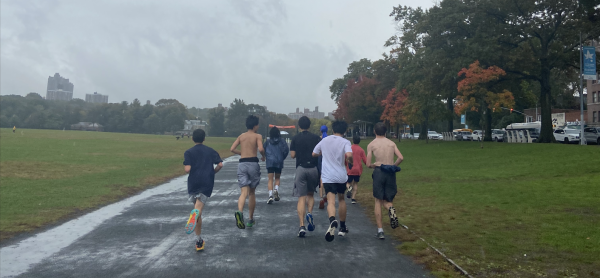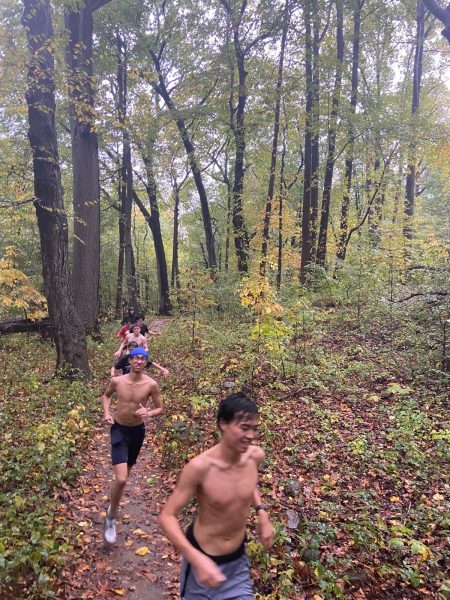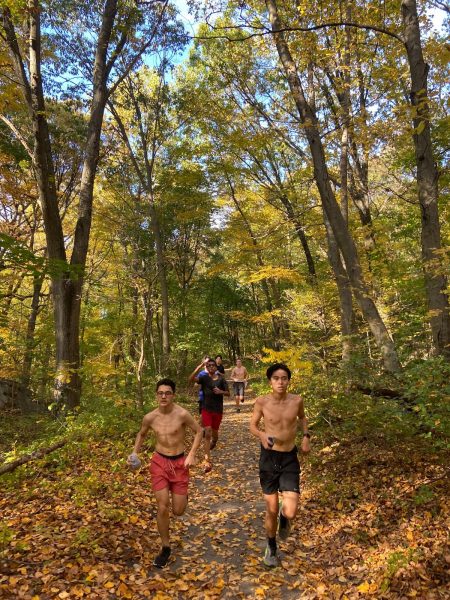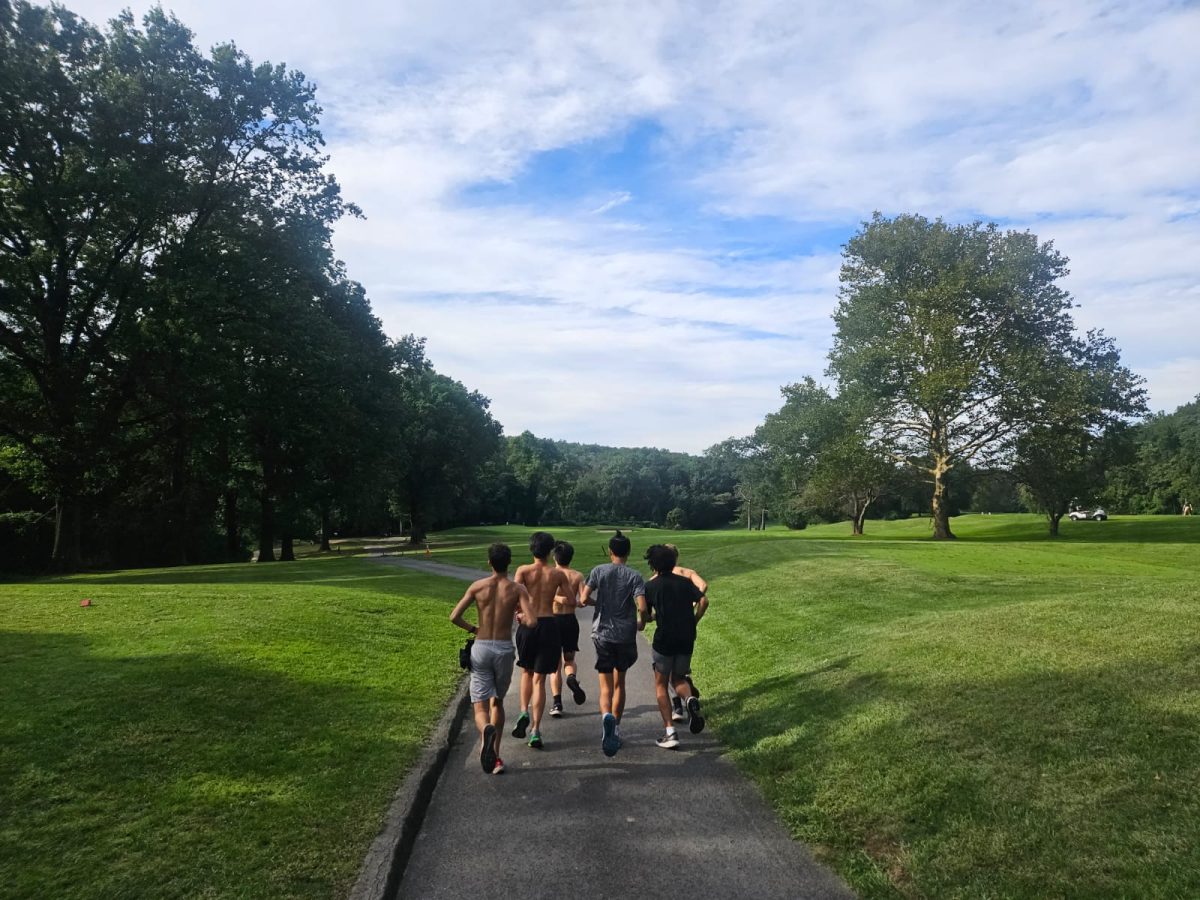Three miles from the bustling halls of Bronx Science, a four foot tall deer chews some grass. The deer is at peace in the woods of Van Cortlandt Park, but unfortunately, so is the Bronx Science Boys’ Varsity Cross Country team. As the team runs past, the deer becomes startled and runs deeper into the woods. For the Cross Country team, this is just another Wednesday in New York City.
Sports are one of the most popular extracurricular activities at the Bronx High School of Science, but where most athletics teams at Bronx Science practice on well kept lawns or in indoor gyms, the Boys’ Varsity Cross Country team stands out. Instead of passing a ball back and forth, cross country runners spend their time running through the woods and to new places. This distinguishes the Bronx Science Boys’ Varsity Cross Country team from other sports offered at Bronx Science that are limited to a few gyms, fields, and courts.
In PSAL, running the five kilometer (3.1 mile) race through Van Cortlandt Park is one of the staples of participating in cross country. The woods and fields of the park allow student athletes to experience real nature within the boundaries of New York City. Unlike many other New York City parks, Van Cortlandt is largely undeveloped. This makes for a very scenic racing course. In spite of this fact, it always takes a toll on runners.
Over the years, the Bronx Science Boys’ Varsity Cross Country team has had its moments of success on courses such as the one at Van Cortlandt. In 2019, the varsity team won the Public School Athletic League’s city championship cross country race. That same year, the top two runners, alumni Sawyer Cooper ’20 and Nathaniel Lentz ’20 ran the five kilometer Van Cortlandt park course in elite times of 16:32, and 16:34. These each equate to approximately 5:20 per mile: a good time for one mile, let alone 3.1.
Times have changed, and some could argue that the team has been in a slump since 2021. Roadblocks such as the Coronavirus pandemic, injuries, and a lack of organization in terms of schedule and leadership have reduced the Bronx Science team to less than it was. This year, there is new hope for team success. In this season, with better organization in terms of schedule, a stronger work ethic, and some fresh talent, many team members are optimistic about having a strong team by the 2024 season.

In cross country, athletes compete to be ranked as one of the top seven runners of their team. Being in the top seven is significant, as it gives athletes a chance to compete in the “varsity” race category rather than the “junior varsity” one. In cross country races, the top five people on the team score points, and the last two positions run as backup, so it is crucial to have a robust top 7.
In Cross Country, the lower the total of team points the better. In competition, fifteen points is a perfect score. This happens when one team claims the top five positions of a race. At this year’s sophomore Bronx Borough Championships, the Bronx Science team achieved a 15 point score.
Liam Hernandez ’26, a promising new member of the team, was one of the athletes who helped achieve this perfect score by placing in the top five. His evident talent and work ethic lead many people on the team to believe that he is close to claiming a varsity spot. When asked what it’s like to be that close and feel the pressure, Hernandez said, “it feels good, and I think that I can meet those expectations if I stay consistent.” Another talented new runner on the team, Kyle Lee ’26 transferred to Bronx Science after spending his ninth grade year at another high school. When asked what makes the Bronx Science team different from his old one, Lee said, “The kids who aren’t in varsity are pushing varsity in order for them to keep the spot,” highlighting the team’s competitive attitude.

Running workouts are arguably the most important aspect of cross country training for improving race times, and it is where team members gain ground over each other. At Bronx Science, these normally take place twice a week. Oftentimes, runners for the team will run repeats of a hill as per the coaches instructions. This is always preceded with a warm up and succeeded with a cooldown. These are short and slow lengths of running that serve to prepare for the workout, and slow down afterwards.
It is on these days that it is important for athletes to push themselves. These workouts build both fitness and familiarity with the course and racing strategies. Most practices are on the same course through Van Cortlandt that the 5k race takes place on; when they aren’t, the workouts normally tie in to improving racing strategies for the season.
Most often, workouts for the Cross Country team happen in the “back hills” section of the Van Cortlandt Park course. This is a 1.4 mile stretch of trail with tight turns, steep uphills, and a long section of downhill. In the woods of the park that are separate from the backhills, there are other notorious hills – Cemetery Hill and Freshman Hill – known for being steep. Workouts often incorporate these hills in order to push the athletes.
Although Cross Country as a sport has its fundamentals of training and a culture of competition, that is not what holds the Bronx Science team together. Workouts and races prepare athletes for competition, but the days that bring the team together are the relaxed ones. It is on these days when the strongest team bonds are built. For many, the exploring and conversations between team members is what they enjoy the most. Easy days give athletes an opportunity to think about more than just the competition that is constant in all sports of all schools.
In cross country, taking too many days off can lead to getting out of shape. For this reason, it is very rare that an easy day means a day off of running. To make the commitment of running daily a little easier, many runners run in groups on easy days regardless of attendance requirements set by the coach. Members of the Bronx Science Boys’ Varsity Cross Country team are fortunate enough to have the opportunity to explore new places for running.
Specifically for Bronx Science, runners are able to distance themselves from the average city-dwelling lifestyle. On easy days, the only criteria for recovery runs are an expected amount of mileage at a comfortable pace. This lack of parameters allows for freedom. Runs like this help with building team dynamics and reducing the stress of the workload of the cross country team. The team dynamic is essential to team performance. Jesse Berman ’26 said, “I feel like we have a really good community.” When asked if the team dynamic helps him get through tough moments in running, Berman said, “Yeah, it definitely does. I feel like I run faster when I am running with a group.”
The team dynamic also makes the team more competitive when it comes time to race. “The cross country team is different here because everyone is pushing each other, meaning that the team is growing together. I chose to join cross country because runners are all so nice and the community is amazing no matter what level you are at everyone is supportive. As long as you are there to work harder and improve yourself that is all that matters,” said Lee.
While many athletes of other sports are in the school gym practicing, cross country athletes can sometimes end up as far away as Yonkers. Running into the woods of Van Cortlandt park, to the Hudson River, and into the suburbs gives the Bronx Science team a special experience. With a little bit of digging on Strava, an app that many cross country athletes in New York city use to track runs, one can quickly find that most of Bronx Science’s competitors in cross country run on city streets, or in highly developed parks like Central Park.

The location of Bronx Science means that easy runs are often more interesting than that. I joined a small group of runners on the Bronx Science Boys’ Varsity Cross Country team, and as a group we ran a few miles out on a secluded trail. In conversation, some runners mention seeing skunks, rabbits, and deer, on previous easy runs.
As someone who has been on the team since my ninth grade year, some of my favorite memories include exploring on runs with the team. At the end of the day, many are on the team because they enjoy it, just as is the case with most sports. While a stereotypical argument is that cross country running is the “punishment” of other sports, or that it is the only sport that you don’t “play,” it can be fun. What keeps people going is that everyone is in it together. After a long day of classes at Bronx Science, there’s nothing like going far into nature and disconnecting from the everyday academic rat race.
“The cross country team is different here because everyone is pushing each other meaning that the team is growing together,” said Kyle Lee ’26.

